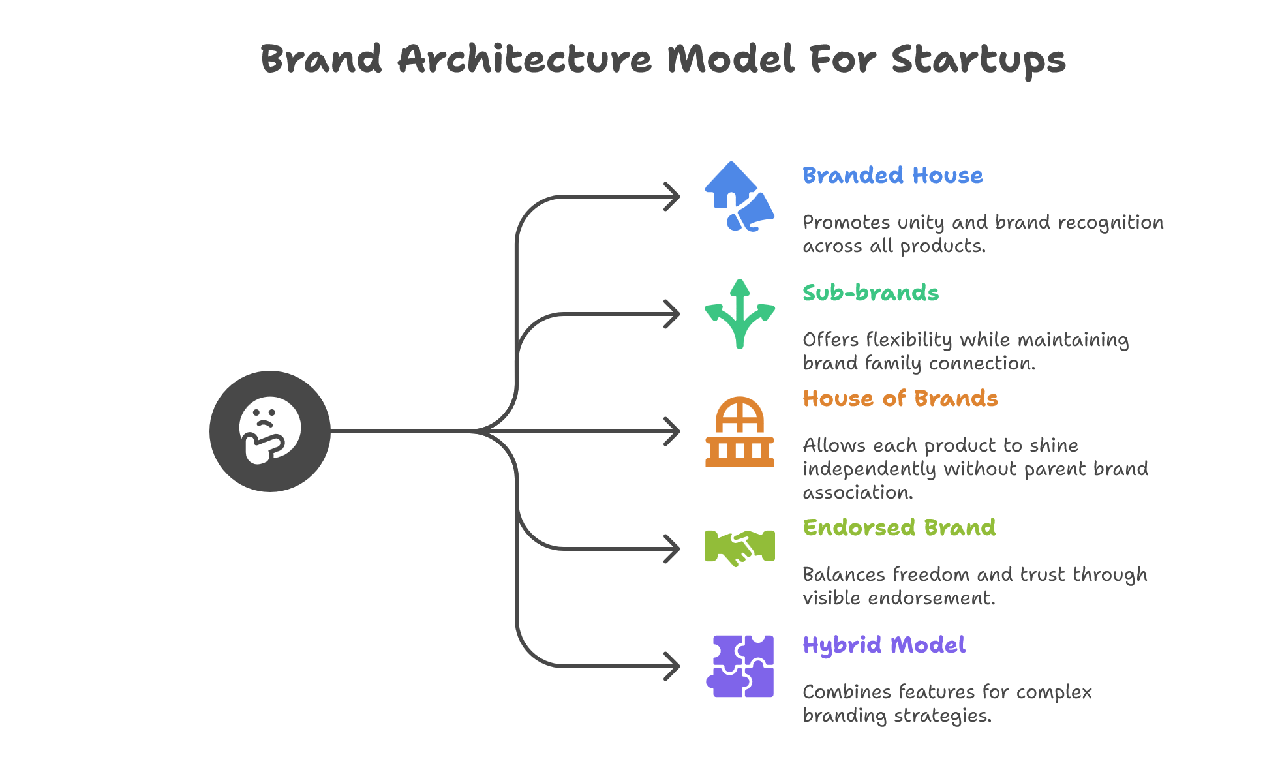Brand Architecture for Startups Types & Models with Examples

A startup must define an identity as strong as possible from day one. Without it, customers get confused about who you are. Brand architecture allows you to put that clear identity together. It shows how your brand connects to products and sub-brands. This specific structure is not only useful but necessary from the MVP stage.
A clearly laid-out brand architecture framework generates considerable trust for a startup. It helps people identify with its mission and offerings. On the other hand, it helps the company employees maintain focus and be consistent with the brand identity.
What is Brand Architecture?
Brand architecture is the structured system that defines how a company’s brands, sub-brands, and products are organized, related to one another, and presented to consumers in order to create clarity, consistency, and market impact.
From MVP to brand narrative: Bridging product and identity
Most startups begin with a small product idea or a minimum viable product (MVP). However, a product does not tell your entire story. This is where brand architecture meets brand storytelling. Your brand narrative lets the world know why you matter. It associates your product with emotion, values, and goals.
As your MVP turns into a full-fledged product, so should your story. Throughout this, visual identity, voice, and values must go hand in hand. This instils trust and emotional connection into users' minds.
Let's look at some brand architecture types available for startups.
Types of brand architecture models for startups

Framework is just as important as style when you're building a brand. Startups often grow fast, and confusion can happen quickly. This is where a strong brand architecture helps make things simple. It shows how your products and services connect with each other. It helps your customers learn about your business better.
As your business starts to grow, it will need more direction and structure. Each model suits a different kind of startup or product. Some work better for small startups, others for big businesses. Let's take a look at each model with some clear brand architecture examples:
1. Branded house
In this model, all products use the same brand name. The company promotes one main brand across every product or service. Startups with one focus or offering usually prefer this setup. The brand name is always front and centre across all items. It creates unity and builds stronger recall in the market.
A perfect example of a Branded House is Google. Google has products like Gmail, Maps, Drive, and Search. But all of them start with “Google” in their names.
Pros:
-
Builds strong brand recognition across all services.
-
Marketing is easier and more cost-effective.
-
Trust in one product boosts others.
Cons:
-
One failure can hurt the entire brand.
-
Limited freedom for sub-products to stand out.
2. Sub-brands
Sub-brands are part of the main brand but feel separate. They have their own names, identity, or style but stay connected. This model works when each product has a special purpose. It offers more freedom while still keeping the brand family strong. Startups growing into new markets often use this approach best.
Apple would be a great example of this model. This brand has sub-brands like the iPhone. Each product, like MacBook, iPad, or AirPods, stands on its own. They are all clearly linked to the Apple label, though.
Pros:
-
More flexibility to target different users.
-
Sub-brands can have unique marketing.
-
Keeps connection to the main brand.
Cons:
-
Confusing if not managed carefully.
-
Risk of diluting the parent brand.
3. House of brands
This model means each product has its own brand identity. They don’t show a connection to the main company brand. It’s great for startups managing many unrelated products or services. It offers full freedom for each brand to shine separately. You won’t see the parent brand name anywhere on the packaging.
Procter & Gamble (P&G) is a famous house of brands. They own Tide, Pampers, Gillette, and more, all standalone brands. Customers may not even know they belong to the same company. This setup gives each product full control of its branding.
Pros:
-
Each brand has full creative control.
-
Problems with one brand don’t hurt others.
-
Easier to sell or discontinue brands.
Cons:
-
Costly and complex to manage.
-
No shared trust or loyalty from the parent company.
4. Endorsed brand architecture
In this model, the main brand “endorses” them visibly through logos or taglines. It creates a balance between freedom and connection in branding. Startups looking for trust and flexibility often prefer this style.
An example of endorsed brand architecture is Courtyard by Marriott. The “Courtyard” hotel has its own identity and feel. But the name “Marriott” is always shown alongside it, too. This tells customers the sub-brand is supported by Marriott.
Pros:
-
Builds on the trust of the parent brand.
-
Allows sub-brand creativity.
-
Helps enter new markets easily.
Cons:
-
Mistakes from sub-brands affect the parent.
-
Hard to manage brand consistency.
5. Hybrid model
This one combines the features of all the models mentioned above. It mixes unity, independence, and endorsement across different products. Many growing startups or large companies choose this complex setup. It gives freedom to build new products with smart brand logic. But you must plan carefully to avoid messy architecture and branding.
A strong hybrid brand architecture example is the Coca-Cola Company[1]. Coca-Cola uses a branded house for Coke, Diet Coke, etc. However, they also own separate brands like Sprite and Minute Maid. Some products carry endorsements; others are fully independent.
Pros:
-
Best of both branded house and sub-brand models.
-
Supports growth and product variety.
-
Flexible for different markets and user types.
Cons:
-
Needs careful planning and strategy.
-
Confusing if not structured well.
Aligning brand architecture with product strategy
Your strategies for product and brand architecture must work together. They are like two sides of the same coin. One affects how you build; the other affects how users see you.
If your product line is focused, a branded house might work well. If you plan to grow into many markets, a hybrid brand architecture may suit you better. Think about where your startup will be in five years. Then, match your architecture and branding to support that vision.
5 common branding pitfalls startups face post-MVP
Branding isn’t a one-time thing you do and forget. Startups often hit bumps once they move beyond MVP. These mistakes can weaken their brand and confuse customers.
- No clear product direction
Some teams launch products without a solid long-term product plan. Their brand keeps shifting with every new feature, which makes it hard for users to trust them.
- Trying to do too much
Adding too many features early creates clutter and confusion, which weakens the brand message and user experience.
- Making the MVP too complex
An MVP should be lean and focused. A bulky MVP confuses users and delays brand clarity.
- Hiring too many people early
A large team can pull the brand in different directions. Without a clear brand architecture framework, everyone makes their own version of the brand.
- Feedback overload
Feedback is helpful, but too much of it kills focus. Startups must filter input and protect their core brand story.
Creating a flexible brand system for growth
Brands are not fixed - they must evolve. But they also need a strong base. That’s why startups should build systems, not just logos.
A flexible brand system includes visuals, tone, messaging, and structure. It also includes rules for how sub-brands grow or how products get named.
Your brand architecture should make future growth easier, not harder. It should support new products, new markets, and even new user types. Tools like brand guidelines, naming playbooks, and brand architecture frameworks can help a lot.
How GrowthJockey can help build a brand architecture for your startup
GrowthJockey helps startups build strong brand architecture strategies, focusing on both structure and storytelling. That means your brand stands clear inside and outside.
Our team works with founders to create scalable systems. Whether you need endorsed brand architecture or a simple branded house, GrowthJockey - Full Stack Venture Builder is here to guide you with the right tools and templates. Our mix of smart strategy, sharp creativity, and startup speed keeps your brand on track every step of the way.
FAQs On Brand Architectures
1. What are the three brand architectures?
The three main brand architectures are branded house, house of brands, and endorsed brand architecture. A branded house uses one name for all products. A house of brands has separate brands for each product. An endorsed brand links sub-brands to a parent name. Some companies also use a hybrid brand architecture.
2. What are the principles of brand architecture?
Good brand architecture is based on three things: clarity, consistency, and scalability. People clearly know what your brand stands for. Consistency keeps your message flowing seamlessly across channels. Scalability is about growing without confusion.
3. What are the key elements in brand architecture?
The Brand architecture includes your main brand, sub-brands, and product names. It also describes the interface between those elements: design rules, tonal messaging, and even storytelling style.








